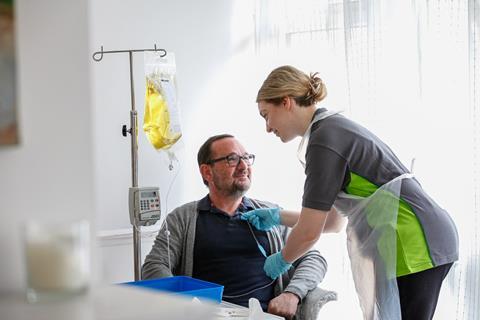![]()
This is paid-for content from our commercial partners. Find out more
Ruth Poole, healthcare director at Celesio, looks at the challenges facing the clinical homecare industry that are prompting innovation and new models of care

When clinical homecare was first established it was leading edge, but nearly three decades on, receiving specialist medicines at home is a bit more routine. The range of treatments that can be delivered outside hospitals has increased substantially, and there is still much potential to extend the service if we include all medicines known to be suitable for homecare.
Practical recommendations from the Hackett Report have been implemented, but since its release new models of care are developing in response to an ever-changing healthcare environment, and evolving patient need and expectation.
So what happens next?
The dilemma is ensuring that the cost/choice/sustainability continuum is navigated to ensure better patient outcomes whilst providing value for the NHS. An ageing population with multiple long-term conditions and more complex care requirements means that limited budgets have to stretch even further and prices are pushed down. Add to this the fact that the system is short of clinical staff to provide specialist nursing, we have a perfect storm, and providers need to look at how they maximise scarce resource whilst maintaining high levels of patient care.
In association with

The solution surely lies in a mixed model that enables a more personalised and flexible approach for patients. Not all patients are housebound and because of medical advancements, patients can live an active life whilst managing a long-term condition. However, any alternative care model needs to guarantee an appropriate interaction with a healthcare professional who can perform a quality intervention when required.
Through our work with the hospital pharmacy teams, we have identified patients such as those living with HIV who require medication, but still live active lives. In cases like these there is a need for a more flexible homecare model, where instead of waiting for medicines to be delivered to their home patients could collect medicines from a local pharmacy, at their convenience.
Taking the time to explore less complex models of care to suit changing patient needs not only provides efficiencies for delivery costs, but also provides a more flexible solution for patients which is essential to improving patient outcomes.
When it comes to the challenges we face around workforce we know the demand is clearly outweighing the resource available. With more complex therapies moving to homecare models of care, we need to look at how we leverage our healthcare professionals more effectively.
Working with North Lincolnshire & Goole we have developed a mixed model of homecare where patients can now go to a local LloydsPharmacy to receive hospital treatment that involves subcutaneous injection and intravenous treatments. This model enables us to use homecare nursing within local pharmacy to improve productivity, increase patient choice, and ultimately improve outcomes.
We believe that local pharmacy and the pharmacist has a much wider role to play in future homecare and by the end of this year our ambition is to upskill our pharmacists to provide subcutaneous injection treatments to release further nursing capacity, so that they can provide more complex IV therapies.
A community pharmacy-based service is an accessible and convenient setting for patients, with advice and medicine adherence support on hand. LloydsPharmacy Healthcare Centres will provide an alternative nurse-led service that increases patient choice, keeps them out of hospital and crucially, drives a positive clinical outcome. The provider benefits from increased productivity for nursing staff with multiple patients being treated in the same environment. Trusts are able to free up time and capacity in hospitals to concentrate on those patients, or therapies that need it. Clinicians retain control and can be assured that quality is maintained.
It’s all about meeting patients’ needs where they are, either in their disease journey or in their lives - flexibility is crucial. Offering choice to the patient such as hospital, local community, and in their own home can help them optimally comply with their healthcare regime which is not only better for them, it is cheaper.
After all, supplying services in a way that suits the patients and can be delivered closer to their home makes sound economic sense; good clinical outcomes = better value and sustainable healthcare.
And that helps us all.
To find out more about how we are delivering care closer to patients’ homes, please go to www.lloydspharmacyservices.co.uk/healthcarecentres/.


























